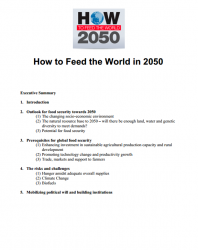
How to Feed the World in 2050

Executive Summary Excerpt
By 2050 the world’s population will reach 9.1 billion, 34 percent higher than today. Nearly all of this population increase will occur in developing countries. Urbanization will continue at an accelerated pace, and about 70 percent of the world’s population will be urban (compared to 49 percent today). Income levels will be many multiples of what they are now. In order to feed this larger, more urban and richer population, food production (net of food used for biofuels) must increase by 70 percent. Annual cereal production will need to rise to about 3 billion tonnes from 2.1 billion today and annual meat production will need to rise by over 200 million tonnes to reach 470 million tonnes.
This report argues that the required increase in food production can be achieved if the necessary investment is undertaken and policies conducive to agricultural production are put in place. But increasing production is not sufficient to achieve food security. It must be complemented by policies to enhance access by fighting poverty, especially in rural areas, as well as effective safety net programmes.
- Issue:
- Natural Resources
- Region:
- Global
- Year Published:
- 2009
- Institutions:
- Food and Agriculture Organization (FAO), United Nations

